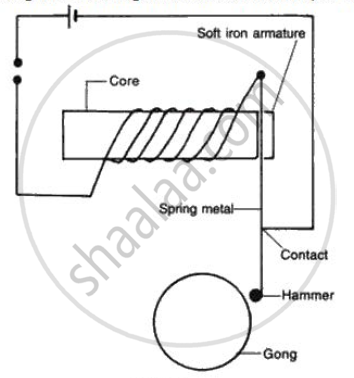Advertisements
Advertisements
प्रश्न
A student wants to use an electric heater, an electric bulb and an electric fan simultaneously.
How should these gadgets be connected with the mains? Justify your answer giving three reasons.
उत्तर
The devices need to be linked simultaneously. The current flows continuously through the whole electric circuit in a series circuit. Consequently, it is plainly impractical to link an electric heater and light in series since they require currents with quite different values to function. Second, another significant drawback of a series circuit is that when one component fails, the entire circuit is destroyed, A parallel circuit, on the other hand, splits the current among the electrical devices. Thirdly, a parallel circuit has less overall resistance. This is helpful particularly when each gadget has different resistance and requires different current to operate properly.
APPEARS IN
संबंधित प्रश्न
Define Electric power
An electric motor takes 5 A from a 220 V line. Determine the power of the motor and the energy consumed in 2 h.
List the names of three electrical gadgets used in your house. Write their power, voltage ratingand approximate time for which each one is used in a day. Hence find the electrical energyconsumed by each in a day.
An electric kettle is rated 2.5 kW, 250 V. Find the cost of running the kettle for two hours at Rs. 5.40 per unit.
Define 1 kilowatt hour.
Fig . shows the essent ial features of a battery operated bell. The hammer strikes the gong when the swi tch is closed . State and explain the effect of using the following material successively to form the core.

(a) Plastic
(b) Steel
(c) Copper
How is the amount of heat produced calculated due to the passage of current in a metallic conductor? Derive an expression for it.
The equation I2R seems to suggest that the rate of heating in a resistor is reduced if resistance decreases, whereas equation P = V2/R suggests just the opposite. How do you reconcile this problem?
A bulb is marked 100W, 220V and an electric heater is marked 2000 W, 220 V.
(i) What is the ratio between the resistances of these two devices?
(ii) How does the power-voltage rating of a device help us to decide about the type of leads (connecting wires) to be used for it?
(iii) In which of the above two devices, a thicker connecting wire of lead is required?
A room has AC run for 5 hours a day at a voltage of 220V. The wiring of the room consists of Cu of 1 mm radius and a length of 10 m. Power consumption per day is 10 commercial units. What fraction of it goes in the joule heating in wires? What would happen if the wiring is made of aluminium of the same dimensions?
`[ρ_(Cu) = 1.7 xx 10_(Ωm)^-8, ρ_(Al) = 2.7 xx 10^-8 Ωm]`
